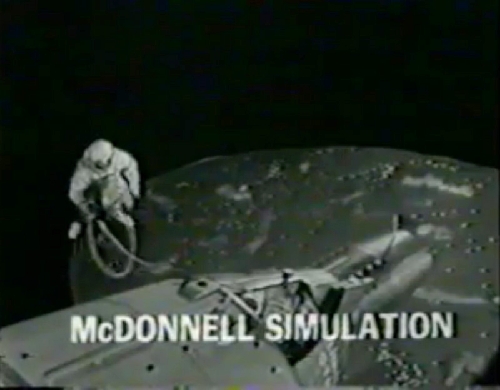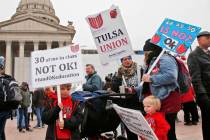Las Vegas company had key role in moon landing
It's been 42 years since the first moon walk on July 20, 1969, and yet there are a few people who argue the whole thing was faked. The folks at the Las Vegas company Flying by Foy don't fall into that category for an important reason. They know portions were faked, and they were the part of the company that did it.
What Peter Foy and the company he founded, Flying by Foy, actually put together was an illustrative simulation and a back up plan.
"Peter approached every project with excitement," said his widow, Barbara Foy. "He really enjoyed his work."
It wasn't technically feasible at the time to keep a live video feed from the Apollo 11 spacecraft in flight. The process of flying to the moon, landing, walking and returning took days, and television was committed to covering as much of the historic event as possible. Radio transmission was available for much of it, but NASA realized that the option of running hours of audio with no images wasn't ideal. So it sought help from theatrical professionals to provide visual simulations to go with the audio.
"I talked to Peter quite a bit about it," said Flying by Foy's archivist, James Hansen. "I think what led them to Peter was a CBS series called 'Men Into Space' starring William Lundigan that ran in the '59-'60 season. It was an entertainment program set in the near future about space travel, and for the time, it was quite accurate. Peter did a lot of weightless simulation work in it. It was produced by the same company that did 'Sea Hunt.' "
State-of-the-art animations simulated the approach and landing on the moon. By today's standards, they look comical, more like footage from an old Buck Rogers movie serial than a news broadcast.
Many of us have seen the grainy footage of Neil Armstrong stepping off the ladder and taking the first step on the moon. What isn't replayed much is the four minutes of simulated moonwalk preparation before the remote cameras were deployed.
Large portions of the original CBS broadcast are available on YouTube. Interspersed with studio shots of Walter Cronkite, the viewers were treated to live footage of actors performing a pantomime of the preparations for the walk on a model of the spacecraft on a set.
NASA engineers were shown opening a hatch in the earthbound lunar module and descending the first few steps of the ladder. A piece of the spacecraft model folded open, simulating the deployment of Modular Equipment Stowage Assembly (MESA), which included the remote camera. Seconds later the footage switched from the clear, well-lit, color simulation to the grainy, high-contrast black-and-white live footage.
At first the live footage was upside down. That problem was soon resolved, and viewers across the world saw Armstrong take the first step on the moon, reciting the now-famous line, "That's one small step for man, one giant leap for mankind."
This wasn't an attempt to fool the public. It was an effort to provide informative visuals and an accurate simulation of a process for which the public had no visual frame of reference. The phrase "CBS NEWS SIMULATION" was repeatedly emblazoned across the bottom of the screen.
"It was also the back up plan in case they lost video transmission," Hansen said. "Fortunately, we didn't. There were the four minutes before the cameras were activated, and that was the last people saw of it. If they had lost the signal, Peter's job would have been to simulate the lighter gravity."
It wasn't Flying by Foy's first simulation work for NASA. Three years earlier, there was no actual footage the Gemini 9 spacewalk, one of the first extra-vehicular activities or EVAs by an American, during a live telecast. On June 5, 1966, while the world listened to astronaut Gene Cernan talking back and forth with mission control and describing his actions, Foy and his crew were on a set at McDonnell Aircraft Corporation's St. Louis plant simulating the actions.
A large model of the surface of the Earth rotated slowly below. Above, a Gemini spacecraft and an NASA engineer in a spacesuit costume were suspended by wires using the same basic flying technology Flying by Foy has used since the '50s to make Peter Pan fly .
"It looks kind of quaint from our point of view now," Hansen said. "But it was great for its time, and NASA was obviously impressed, because they brought him back for the moon walk. There's one funny part where a hatch fell, and they have to remind the audience that it's a simulation."
The gaffe in question came around 42 minutes into the spacewalk when the NASA engineer portraying the astronaut was re-entering the craft. Halfway in the prop vehicle, he leaned on the half- open hatch, which dropped loudly and solidly against the side of the Gemini spacecraft.
"That was a malfunction here at our .... at McDonnell's simulation, not something that happened in space ," Cronkite said. "A hatch flew open. I repeat again that did not happen in the space flight. It happened only here at this remarkable simulation."
In real space, no one can hear you slam.
"Peter was amused by the conspiracy talk," Hansen said. "People don't remember it (the simulation) and speak of it as if it was never seen, but about four minutes were."
Recently, a BBC magazine-style program called "The One Show" did an episode exploring the moon landing conspiracy theories. When it reached the segment about how walking on the moon in low gravity could be faked, it knew there was only one company to go to: Flying by Foy.
Contact Sunrise/Whitney View reporter F. Andrew Taylor at ataylor@viewnews.com or 380-4532.















